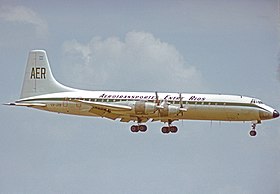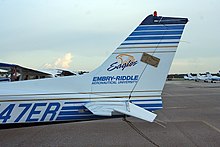Aerotransportes Entre Rios flight 501/90
| Aerotransportes Entre Rios flight 501/90 | |
|---|---|
|
An identical aircraft from the airline |
|
| Accident summary | |
| Accident type | Coming off the runway due to the rudder lock not being released |
| place |
Miami International Airport , United States |
| date | September 27, 1975 |
| Fatalities | 6th |
| Survivors | 4th |
| Injured | 4th |
| Injured on the ground | 1 |
| Aircraft | |
| Aircraft type |
|
| operator |
|
| Mark |
|
| Departure airport |
Miami International Airport , Florida , United States |
| 1. Stopover |
Panama City Paitilla Airport , Panama |
| 2. Stopover |
Lima Airport , Peru |
| 3. Stopover |
Santa Cruz Airport , Bolivia |
| 4. Stopover |
Asunción Airport , Paraguay |
| Destination airport |
Buenos Aires Ezeiza Airport , Argentina |
| Passengers | 4th |
| crew | 6th |
| Lists of aviation accidents | |
The Aerotransportes Entre Rios flight 501/90 (flight number: RS501 / 90 ) was an intercontinental cargo flight of the Argentine cargo airline Aerotransportes Entre Rios on September 27, 1975. On that day, a Canadair CC-106 Yukon crashed to Panama City should fly when taking off from Miami International Airport . Six of the ten people on board the machine were killed in the accident.
machine
The aircraft was a 1961 Canadair CC-106 Yukon with the serial number 5 . The machine completed its maiden flight on March 25, 1961, before it was delivered to its customer, the Royal Canadian Air Force , on May 23, 1961, where it was put into service with the 437th Transport Wing (RCAF 437 Sqn.) On Canadian Forces Base Trenton . The machine received the military aircraft registration number 15925 , which it kept when the unit on February 1, 1968 in Canadian Armed Forces 437 Sqn. was renamed. On May 26, 1970 the registration number was changed to 106925 . The machine was phased out in the same year and bought on November 1, 1970 by International Aerodyne and stored in Montréal . On November 13, 1970, the machine was sold to Aerotransportes Entre Rios and re-registered with the new license plate LV-JSY . On May 27, 1972, the aircraft suffered a landing incident when it was touched down with the landing gear retracted at Buenos Aires-Ezeiza Airport . The aircraft was then repaired and put back into service. The four-engine long-range - cargo aircraft was equipped with four turboprop engines of the type Rolls-Royce Tyne 515-10 equipped. By the time of the accident, the machine had had a total operating performance of 20,108: 54 operating hours, which accounted for 5,891 take-offs and landings.
Inmates
There was a six-person crew on board the machine, consisting of two cockpit crews who were supposed to take turns on the long flight route. There were also four passengers on board who were entrusted with handling the freight being carried. At the time of the accident, the machine was controlled by the following three crew members:
- The 49-year-old flight captain Pedro Jose Guerra worked for Aerotransportes Entre Rios from August 4, 1972. In addition to the Canadair CL-44, he had a type rating for the Curtiss C-46 . Guerra had 11,601 hours of flight experience, of which he had flown 2,352 hours in the Canadair CL-44.
- The 30-year-old First Officer Richard Hofmann was hired by Aerotransportes Entre Rios on December 5, 1974. He had 1,876 hours of flight experience, 486 of which he had in the Canadair CL-44.
- The 51-year-old flight engineer Carlos DaCruz worked for Aerotransportes Entre Rios since August 5th, 1971. In addition to the Canadair CL-44, it was also certified for the Douglas C-47 and the Lockheed L-749 Constellation . His cumulative flight experience was 5,449 hours, of which he had completed 3,539 flight hours in the cockpit of the Canadair CL-44.
freight
The cargo consisted of aircraft engines , tractor and vehicle parts , and perfume . The perfume - a flammable liquid - was properly packaged and labeled.
the accident
Before take-off, the crew submitted a flight plan which stated that the flight to Panama City was to be carried out in instrument flight . At 5:55 a.m., the machine was cleared for taxiing to runway 27L at Miami Airport. The take-off run began at around 6:00 a.m., in the dark (sunrise in Miami was at 7:11 a.m. that day), under visual flight weather conditions . The take-off run seemed normal at first, but the machine did not take off when it reached rotational speed . Two to three seconds later, the master initiated an aborted take-off by activating the thrust reverser and applying the landing gear brakes. The machine overshot the end of the runway, collided with the ILS antennas and breached the airport fence. The machine rolled over a lawn 879 feet past the runway before rolling over the Perimeter Road outside the airport and falling into a drainage channel beyond it, between the Inner Perimeter Road and the Outer Perimeter Road. The front fuselage section was torn off and slid over the Outer Perimeter Road, where it collided with a parked VW bus , the occupant of which was injured. The machine went up in flames after impact and burned out completely.
Victims and survivors
Four of the six crew members and two of the four passengers were killed in the accident. Only two passengers and two crew members survived.
causes
The National Transportation Safety Board (NTSB) investigated the incident. The accident report was published on March 10, 1976. The investigators determined that the cause of the accident was the execution of the take-off run without first removing a temporary wooden rudder lock on the elevator , which was attached to the right Flettner rudder . The elevator could therefore not be brought into the position required for take-off.
The rudder lock was not one of the machine's certified assemblies. The CL-44 was factory-fitted with a hydraulic rudder lock system, which, however, was either modified or deactivated in most machines of this type after an aircraft accident in 1970 after it was discovered that the machine involved in the accident had crashed after the rudder lock system was automatically activated in flight would have. Aerotransportes Entre Rios was one of the airlines that deactivated the system. She used temporary external wooden rudder locks that were attached to the oars by the crew between flights.
swell
- Accident report CC-106 Yukon, LV-JSY in the Aviation Safety Network
- Final report of the National Transportation Safety Board
- Crash of a Canadair CL-44-6 in Miami: 6 killed , B3A - Bureau of Aircraft Accident Archives
- Serial # 5 Type CL-44-6 / CC-106 Yukon , cl44.com

